Digbeth, Birmingham’s vibrant creative quarter, boasts a thriving public art scene that captivates visitors. Towering murals, intricate stencils, and bold graffiti adorn the area, reflecting the city’s industrial heritage, social issues, and cultural diversity. Beyond the street art, Digbeth also serves as a key filming location for the acclaimed TV series ‘Peaky Blinders,’ with the iconic Garrison Pub and gritty industrial landscapes evoking the show’s post-WWI setting. Delve deeper into this dynamic district, where captivating public sculptures and art galleries further enhance its reputation as a hub of creativity and cultural expression.
Key Points
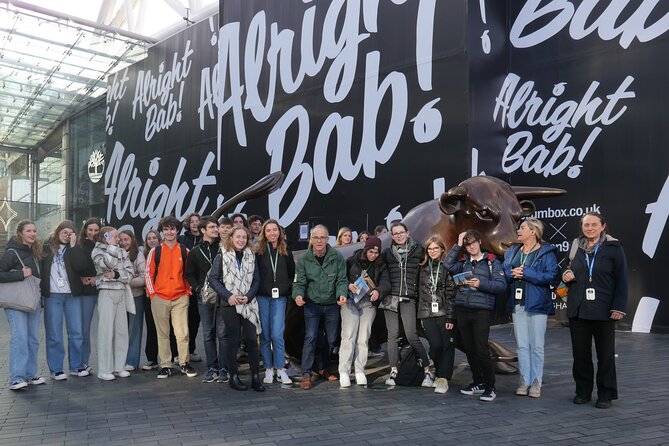
- Digbeth is renowned for its vibrant street art scene, featuring towering murals, intricate stencils, and bold graffiti inspired by the city’s industrial heritage and Peaky Blinders.
- Birmingham’s urban landscape is dotted with captivating public sculptures, including the iconic Bull statue and the Three Figures sculpture that explore the human form.
- Key filming locations for the TV series ‘Peaky Blinders’ can be found throughout Digbeth, including the Garrison Pub and the industrial landscapes that evoke the show’s post-WWI setting.
- Digbeth’s diverse array of art galleries, such as Stryx Gallery and Minerva Works, showcase cutting-edge contemporary art and independent designer-makers.
- Digbeth’s industrial heritage is reflected in its towering brick chimneys and weathered factory facades, which serve as canvases for vibrant murals and street art.
Exploring Digbeth’s Street Art
Tucked away in the heart of Birmingham, Digbeth’s vibrant street art scene offers a captivating journey through the city’s creative pulse, showcasing the work of local and international artists.
From towering murals adorning the sides of buildings to intricate stencil work and bold graffiti, the area’s walls serve as a canvas for self-expression.
Visitors can discover thought-provoking pieces that reflect the city’s industrial heritage, social issues, and cultural diversity.
Whether it’s the iconic Peaky Blinders-inspired art or the ever-evolving collaborations between artists, Digbeth’s streets provide a constantly changing outdoor gallery that celebrates the power of public art to inspire and engage.
This gritty, urban landscape is a must-see for anyone exploring Birmingham’s artistic side.
You can also read our reviews of more tours and experiences in Birmingham.
Discovering Public Sculptures
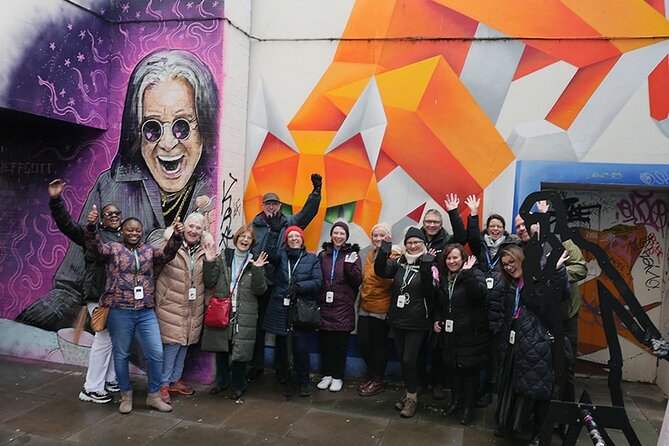
Alongside Birmingham’s vibrant street art scene, the city’s public sculptures offer a captivating exploration of the area’s artistic heritage. From towering bronze figures to striking abstract installations, these monumental works dot the urban landscape, inviting visitors to engage with the city’s rich cultural tapestry.
One of the most prominent examples is the iconic Bull statue by Laurence Broderick, situated in Centenary Square. Its powerful presence commands attention, symbolizing Birmingham’s industrial might.
Nearby, the Three Figures sculpture by Raymond Mason explores the human form with a contemporary twist.
Further afield, Dhruva Mistry’s The Kailash evokes ancient Indian mythology, standing as a testament to the city’s diverse cultural influences.
Peaky Blinders Film Locations
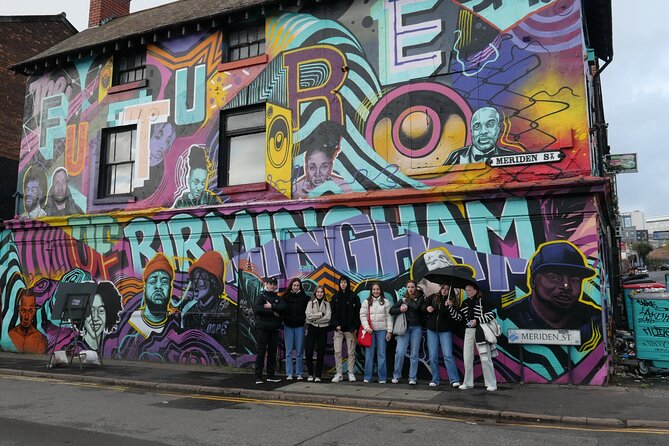
Along With Birmingham’s captivating public art, the city has also served as a backdrop for the gritty period drama ‘Peaky Blinders,’ allowing visitors to enjoy the world of the notorious Shelby family.
Fans of the show can explore key filming locations throughout the city, including:
- The Garrison Pub, the Shelby family’s infamous hangout, located in the heart of Digbeth
- Cheapside, where the Peaky Blinders conducted their business dealings
The industrial landscapes of Digbeth, which evoke the show’s post-WWI setting.
The ornate interior of Birmingham Town Hall, which doubled as a courtroom in the series.
The serene canals of Birmingham, where the Shelbys often conducted their illicit activities.
These locations offer a unique glimpse into the show’s captivating world and the rich history of Birmingham itself.
Art Galleries in Digbeth

Digbeth, Birmingham’s creative quarter, houses an array of art galleries that showcase the city’s thriving artistic talent.
From experimental contemporary spaces to traditional showcases of regional craftsmanship, these galleries offer visitors a diverse and immersive art experience.
Stryx Gallery, for instance, presents cutting-edge installations and exhibitions, while the Minerva Works hosts an eclectic mix of independent artists and designer-makers.
The Custard Factory, a hub of creativity, is home to numerous galleries and studios, allowing visitors to explore a wide range of mediums and styles.
Whether you’re drawn to avant-garde sculptures or hand-crafted ceramics, Digbeth‘s art galleries provide a dynamic and engaging exploration of Birmingham’s vibrant cultural landscape.
Murals and Wall Paintings
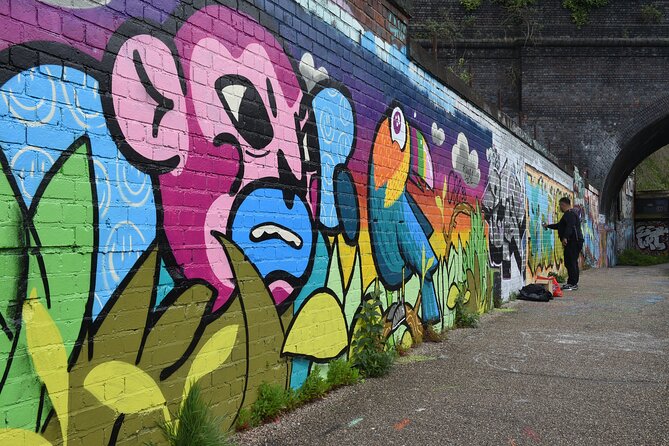
Vibrant murals and captivating wall paintings adorn the urban landscapes of Digbeth, transforming the city’s surfaces into open-air galleries that captivate passersby. From towering depictions of local icons to vibrant abstract designs, these public artworks showcase the creative talent and diverse cultural influences that define Digbeth’s artistic identity.
Renowned street artists like Gent 48 and Annatomix have left their indelible marks, transforming once-drab walls into stunning visual masterpieces.
Murals reflecting Birmingham’s industrial heritage and multicultural communities can be found around every corner, inviting visitors to explore and discover the neighborhood’s rich artistic tapestry.
These public artworks not only beautify the area but also serve as a platform for social commentary, storytelling, and community empowerment.
- Survival Escape Room Game in Birmingham
- Digbeth, Public Art & Peaky Film
- Skip the Line: House and Garden Admission Ticket
- Birmingham Slogging Gangs Walking Tour With Edward Shelby
- Fun, Flexible Treasure Hunt Around Birmingham With Cryptic Clues & Hidden Gems
- Iconic Birmingham: A Journey Through Heart & Heritage
Industrial Heritage Architecture

Towering brick chimneys and weathered factory facades dot Digbeth’s skyline, standing as proud reminders of the area’s industrial past.
Repurposed warehouses and mills now house trendy galleries, shops, and eateries, blending the neighborhood’s gritty heritage with contemporary creativity.
Along Fazeley Street, the Custard Factory complex showcases the area’s industrial roots, with its distinctive red-brick buildings and ornate architectural details.
Further down the road, the Rea Valley Trail winds through a former industrial corridor, offering a glimpse into Birmingham’s manufacturing heyday.
These striking structures serve as canvases for vibrant murals and street art, creating a dynamic fusion of past and present that embodies Digbeth’s unique character.
Experiencing Digbeth’s Vibe
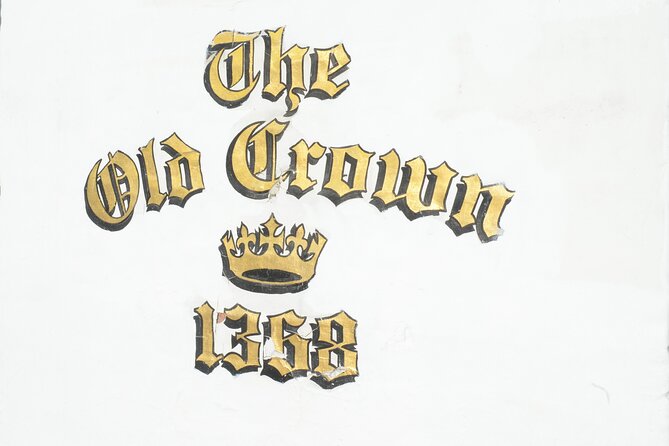
Visitors can enjoy Digbeth’s eclectic energy, wandering through a labyrinth of colorful street art, independent shops, and buzzing cafes. The area’s vibrant vibe is palpable, drawing creatives, foodies, and culture seekers alike.
Explore the neighborhood’s hidden gems, from trendy coffee roasters to vintage record stores. Catch a local band playing at one of the lively music venues or catch a film screening at the independent cinema.
Digbeth’s street art is a constantly evolving canvas, with new murals and installations popping up regularly. With its gritty-yet-charming character, Digbeth offers a unique glimpse into Birmingham’s artistic heart.
- Colorful street art
- Independent shops and cafes
- Lively music venues
- Vintage record stores
- Independent cinema
Guided Walking Tour Details

For those interested in exploring Birmingham’s vibrant art and architecture, the guided walking tour offers an enriching experience. Led by local writer and photographer Jonathan Berg, the tour takes participants on a journey through the city’s past and present, highlighting the evolution of its creative landscape. From the grand Victorian-era structures in Centenary Square to the cutting-edge contemporary installations in Grand Central, the tour promises to pique the curiosities of art enthusiasts and architecture buffs alike.
| Feature | Description |
|---|---|
| Overview | Art-focused walking tour to discover Birmingham’s art and architecture |
| Guide | Local writer and photographer, Jonathan Berg, provides commentary |
| Highlights | Visit Centenary Square, Grand Central, explore art and architecture |
| Inclusions | Use of live audio receiver, bring your own earphones or we can provide for a donation |
Frequently Asked Questions
What Is the Cost of the Walking Tour?
The cost of the walking tour is not explicitly stated. However, the tour includes the use of a live audio receiver, which can be provided for a donation to the charity. The exact tour price is not mentioned.
Is the Tour Suitable for People With Mobility Issues?
The walking tour may not be fully accessible for those with mobility issues, as it involves exploring Birmingham’s art and architecture on foot. However, the organizers can provide assistance or accommodations upon request to ensure an enjoyable experience for all participants.
How Long Does the Walking Tour Last?
The walking tour lasts approximately 2 hours. It covers Birmingham’s art and architecture, starting at 10:30 AM and ending at the Great Western Arcade. The tour provides a live audio receiver for participants to use during the experience.
Can the Tour Be Customized for Specific Interests?
Yes, the walking tour can be customized to focus on specific interests. Guests can work with the guide to tailor the route and content to their art, architecture, or other preferences for a more personalized experience.
Is There an Option to Explore the Area Independently After the Tour?
Yes, the tour allows participants to explore the area independently after the guided portion. Visitors can continue discovering Birmingham’s art and architecture at their own pace using the insights gained from the tour.
Recap
Digbeth’s vibrant public art scene, industrial heritage, and Peaky Blinders filming locations make it a captivating creative hub.
Towering murals, sculptures, and galleries showcase the city’s diversity and cultural expression.
Visitors can enjoy Digbeth’s unique atmosphere through a guided walking tour, exploring the area’s striking visuals and cinematic backdrops.
More Tour Reviews in Birmingham
Not for you? Here's more things to do in Birmingham we have recnetly reviewed
- Birmingham: Christmas Market and Festive Lights Walking Tour
- Cadbury World & LEGOLAND Discovery & Warwick Castle
- Birmingham: All in One Walking Tour
- Birmingham: Discovering Birmingham Guided Walking Tour
- Birmingham Historical Tour
- Birmingham: City Walking Tour and Exploration Game
- Birmingham: The National Motorcycle Museum Ticket
- Birmingham: Guided City Center Walking Tour (10:30am & 2pm)
- Birmingham Learn To Cook Thai
- Birmingham: Delicious Healthy Cooking Classes
- Best of Birmingham: Private Walking Tour with a Local
- Birmingham Slogging Gang Evening Walking Tour with Pub Stops
